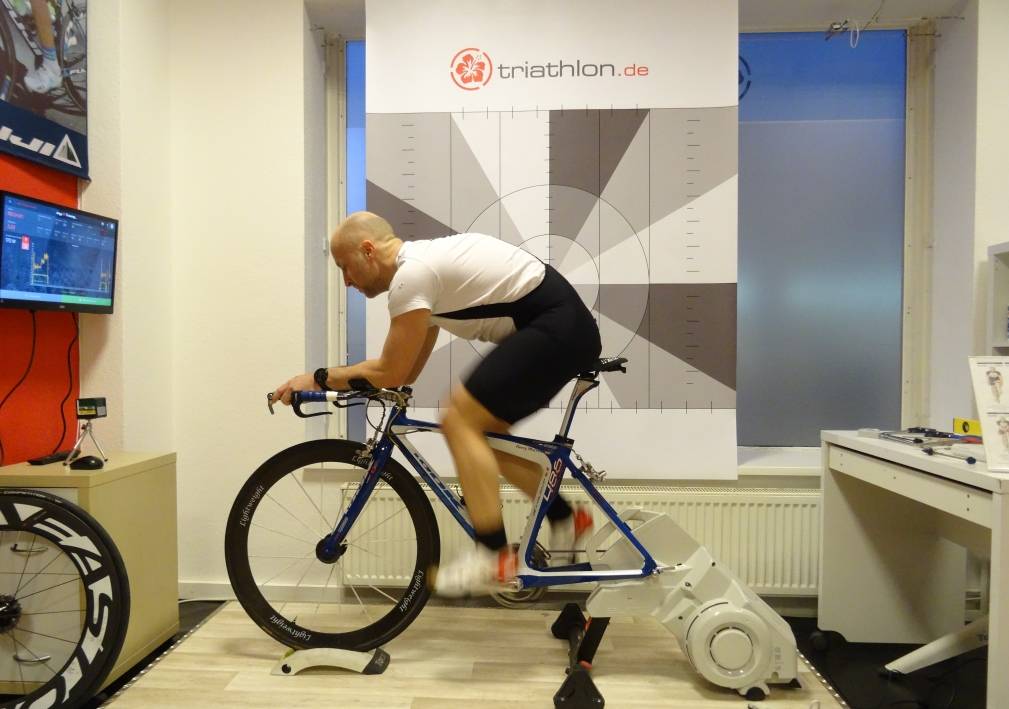Die Einstellung der optimalen Sitzposition hat oftmals einen größeren Einfluss auf die Radleistung als alle Komponenten-Upgrades (Aero-Laufräder, Leichtbauteile, etc). Der Mehrwert drückt sich unmittelbar in vortriebswirksamer Leistung, Geschwindigkeit oder Fahrkomfort aus. Beim Bike Fitting geht es darum „Mensch und Maschine“ zusammenwachsen zu lassen und optimal aufeinander abzustimmen.
Bevor es losgeht
Die richtige Sitzposition ist nicht universell, sondern individuell. Daher berücksichtigt ein gutes Bike Fitting auch beides: Fahrer und Fahrrad. Vor Beginn wird daher zunächst die Ausgangslage beider Komponenten analysiert:
- Um welchen Typ Fahrrad handelt es sich und welche grundlegende Sitzposition ist damit verbunden
- Rennrad/Rennrad mit Lenkeraufsatz/Triathlonrad?
- Stimmt die Rahmengröße oder ist das Rad zu groß bzw. zu klein?
- Wie sind die Körpermaße des Fahrers/der Fahrerin?
- Gibt es anatomische Besonderheiten, Einschränkungen oder sogar schon konkrete Schmerzsymptome?
- Wie ist der radspezifische Trainingszustand und welche sportlichen Ziele verfolgt der Sportler/die Sportlerin?
Die Anamnese bildet die Grundlage für ein zielgerichtetes Bike Fitting. Neben der Vermessung des Sportlers/der Sportlerin können als weiterführende Maßnahmen funktionelle Kraft- und Beweglichkeitstests dem Experten zusätzlichen Aufschluss über den aktuellen Funktionszustand des Athleten geben. Diese Untersuchungen sind insbesondere bei extremen Sitzpositionen (aggressive Zeitfahrposition) oder dem Vorhandensein konkreter Schmerzen zu empfehlen.
Fotos: triathlon.de
Ablauf
Auf Grundlage dieser Informationen kann das eigentliche Bike Fitting nun beginnen. In der Regel handelt es sich um ein „dynamisches“ Fitting, d.h. der Sportler/die Sportlerin soll möglichst realistisch in der Fahrsituation abgebildet werden. Dazu fährt der Athlet mit seinem Rad zumeist auf einem Rollentrainer und wird nun aus verschiedenen Perspektiven analysiert. Im Fokus stehen für den Bike Fitter dabei einerseits vortriebswirksame Parameter, z.B. Kraftübertragung, Tritteffektivität, Aerodynamik, Stabilität und Gewichtsverteilung. Andererseits sind diese aber immer wieder auf ihre anatomisch-funktionelle Belastungsstruktur zu überprüfen (Achsenstabilität, Gelenk- und Wirbelsäulenbelastung).
Der Sportler/die Sportlerin wird nun im Hinblick auf diese Einflussfaktoren Schritt für Schritt vermessen und es werden entsprechende Einstellungen am Rad vorgenommen.
Fotos: triathlon.de
"Bei der Fahrradeinstellung (Sitzhöhe, Sattelposition, Lenkereinstellung, etc.) geht es eigentlich nicht um das Rad an sich, sondern darum, beim Fahrer/der Fahrerin eine biomechanisch optimierte Veränderung in der Sitzposition zu bewirken (muskuläre Aktivierung, Winkelstellungen, Hebelverhältnisse, etc.). Dadurch erfolgt eine messbare Leistungsoptimierung auf dem Rad."
Stephan Schepe ist Sport- und Trainingswissenschaftler. Als Bike-Fitting-Experte und Spezialist für Leistungsdiagnostik betreut den Bereich Training, Diagnostik und Bike Fitting.
Die Anpassung der Sitzposition erfolgt auf vielen verschiedenen Ebenen: Goniometer (Winkelmessgerät), Pendellot, Wasserwaage und Zollstock gehören zur Grundausstattung jedes Bike Fitters und helfen dem Experten, die Sitzposition individuell anzupassen.
Zusätzlich zu diesen „analogen“ Tools können hier ebenso Hochgeschwindigkeitskameras, Linienlaser, Vermessungssoftware oder Druck- und Leistungsmessgeräte zum Einsatz kommen. Dabei werden insbesondere Tritt- und Leistungswerte in jeder Phase der Pedalumdrehung genau analysiert, um das Höchstmaß an Pedaleffizienz und Kraft-Output zu erreichen.
Fotos: triathlon.de
Je mehr Stellschrauben das System besitzt, desto komplexer ist dieser Prozess. Wichtig dabei: nur eine Veränderung nach der anderen durchzuführen. Nimmt man gleich mehrere Einstellungen gleichzeitig vor, lassen sich die positiven oder negativen Effekte nur schwer zuordnen. Grenzen der Optimierung werden dabei manchmal durch die Einstellbarkeit des Fahrrads oder einzelner Komponenten (z.B. Vorbau, Lenkeraufsatz, Sattelstütze) erreicht. In diesen Fällen kann ein Komponententausch durchaus sinnvoll sein, um die gewünschte Sitzposition in Bezug auf Kraftübertragung, Aerodynamik oder Komfort überhaupt erst zu ermöglichen.
Der richtige Sattel
Auch der Sattel spielt beim Bike Fitting im wahrsten Sinne des Wortes eine tragende Rolle. Unterschiedliche anatomische Voraussetzungen, aber auch unterschiedliche Sitzpositionen führen zu deutlichen Veränderungen in der Auflagefläche und Druckbelastung auf dem Sattel – und daher auch zu einer individuell völlig unterschiedlichen Wahrnehmung eines Sattels. Ein gewisser Grad an „Abhärtung“ des Hinterns muss beim Radfahren grundsätzlich vorausgesetzt werden, allerdings ist die optimale Sitzposition auch unmittelbar von einem passenden und „verträglichen“ Sattel abhängig. Eine gute Sattelberatung und die Möglichkeit, Sattelalternativen zu testen, stellen daher auch ein wichtiges Element eines guten Bike Fittings dar.
Die optimierte Sitzposition
Am Ende des Bike Fittings sollte der Fahrer/die Fahrerin in der Lage sein, sich in der getroffenen Einstellung „wiederfinden“ zu können. Veränderungen können sich zunächst ungewohnt anfühlen, da der Körper oftmals anderen Kraft- und Hebelverhältnissen ausgesetzt ist, anders belastet wird – eine gewollte Veränderung!
Abschließend wird das Fahrrad noch einmal vermessen, Maße und Einstellungen werden protokolliert. Eine ausführliche Auswertung geht zusätzlich auf die einzelnen Schritte des Bike Fittings ein, erklärt die Auswirkung der getroffenen Veränderungen (z.B. Vorher-Nachher-Vergleich) und gibt ggf. weiterführende Trainingshinweise.
Bike Fitting bei triathlon.de




















